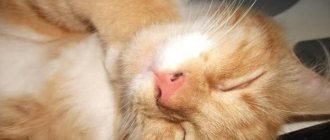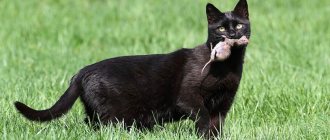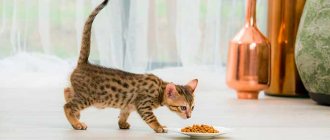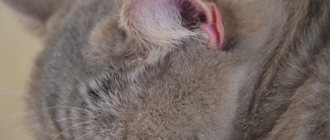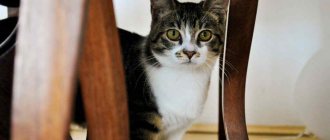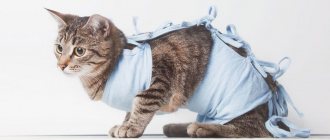What kind of nose does a healthy cat have?
- What kind of nose does a healthy cat have? The nose of a pet that is absolutely healthy is always warm and slightly moist. Such signs are considered completely normal. But there are certain points that you should be aware of.
- Many cat breeds, for example, the Bengal cat , have a constantly dry nose. This is inherent in their nature. It is a dry nose that indicates that the animal is absolutely healthy.
- The Persian cat's nose, on the contrary, is always quite wet. This is because this breed has a slightly flattened muzzle and after the cat finishes washing itself, its nose remains wet.
- The humidity of the nose is often influenced by what exactly the pet eats. Many people claim that cats that eat only dry food have a moister nose than cats that eat natural food. This is because when eating dry food, animals need a large volume of water, and therefore they regularly wet their nose, when they drink water, they lick their lips.
Healthy nose
- A healthy cat, who is constantly active, has a normal psychological state, his nose is not very hot, almost the same as the whole body. It is moisturized, always has the same color, the skin around the nose is elastic and has a uniform structure.
- A cat's nose may be dry and warm according to your opinion, according to your personal feelings. The fact is that the temperature of cats is a couple of degrees higher than that of humans. A wet nose may always seem cold to you, and a dry nose may always seem hot.
Why does my cat have a warm and dry nose?
Cats spend a lot of time awake. They eat, walk, clean their fur and paws, while their nose remains moist.
There are only two reasons why this happens:
- The cat wets its nose with saliva when it licks itself and washes itself.
- The cat secretes nasal glands. They help the animal to catch the odors of the environment and eliminate excess heat.
Normal condition – a healthy pet’s nose is not wet. It's just a little damp, cold, smooth. There are no crusts, purulent or bloody discharge on the nose.
If a cat has clear discharge, this is also not considered a dangerous sign. But your nose cannot be regularly wet.
Dry
There are several main reasons why a cat has a warm and dry nose:
- During sleep , a cat's nose is usually dry. After all, the pet does not lick itself, and therefore saliva does not reach the olfactory organ, and the secretions of glandular cells do not protrude. The nose remains dry and warm for 30-60 minutes until the animal awakens.
- The cat may be near a heat source , for example, it could be a fireplace, a radiator, or a heater. Here everything is very clear - the nose becomes dry due to the device that people connected in order to increase the temperature in the room.
- Mild, non-prolonged discomfort. The disease can be minor, for example, the cat overate, ate hair when it was licked and it got into the stomach. If your cat is a little unwell, then her nose sometimes becomes dry.
- Active movements, games. Due to rapid movement, your pet's body temperature may become higher. Consequently, the nose dries out and becomes warmer.
- In small kittens, thermoregulation has not yet fully adjusted. In addition, the temperature in small animals is usually higher than in adults. This is why an animal's nose sometimes becomes dry, regardless of the time of day.
- If it is hot enough in the house or outside and stuffy, the pet’s nose quickly dries out. And it begins to moisturize after the cat finds itself in normal conditions.
- Stressful state. A cat's nose is dry and warm due to severe fright, during pregnancy, childbirth, and so on.
- Professional cat breeders claim that wet noses in old cats are a rare phenomenon. This happens because over time, the pet’s metabolism may slow down, and the cat itself becomes less active. As in all of these cases, this phenomenon, as a rule, is not considered a pathology.
Why is it dry and warm
? So, we were able to find out why a cat’s nose becomes dry. But he can remain in this state for only a short time. Now let's find out when to worry if your animal's nose has been dry for a very long time.
When a dry and warm nose may be normal
A dry and warm nose in a cat does not always indicate a disease in the animal. There are a number of situations in which it is normal:
- The cat is sleeping or woke up half an hour ago - during sleep, the work of the mucous glands slows down, the liquid gradually evaporates from the surface of the nose, and it becomes dry and warm. After waking up, it takes time to restore the amount of secretion covering the nose.
- Lack of drinking water is freely available to the cat; in this case, the animal cannot compensate for natural fluid losses, and the nose becomes dry, reflecting developing dehydration. To prevent dehydration, your cat should always have access to water.
- Physical activity, active games - when moving, muscle work increases body temperature, metabolism also increases and natural fluid loss increases, while the nose can also become dry. The nose becomes dry and warm in an actively playing cat.
- Emotional stress, stress - cats are very emotional, and unexpected changes in their environment can trigger stress reactions, in which the nose can become dry and warm. Usually, the cat’s behavior changes - it may avoid communication, hide, get angry, and lick itself often and nervously. Dry nose in this case is due to the inhibitory effect on the functioning of the glands of sympathetic impulses of the autonomic nervous system. The cat’s stress reaction either goes away on its own as it gets used to the changed environmental conditions, or you can use sedatives, for example, Fospasim. The nose can become dry and warm under stress.
- Hot and dry air in the room where the cat is kept - in this case, the rate of evaporation of secretion from the nasal mirror exceeds the rate of its formation by the glands of the nose, so the earlobe dries out. A dry and warm nose can be found in a cat basking near a radiator.
- Subjective feelings of a person. Sometimes a person defines the temperature of a cat’s nose as elevated, due to the fact that the normal temperature of a cat is 2 o C higher than that of a person.
If a pet's warm and dry nose persists only for a short time, this is a normal physiological condition. In this case, you need to make sure that the cat has fresh and clean water. A cat may be thirsty but not drink if the water or bowl is not completely clean.
A cat has a dry and warm nose: when is this a sign of illness?
Sometimes a cat has a dry and warm nose - this is a harbinger of a serious illness. Sometimes the illness turns out to be very serious. The nose becomes dry in the following cases:
- Gastrointestinal disorders. A cat can be poisoned by stale, bad food, this can happen after taking antibiotics. In this case, the cat’s nose becomes dry, its body temperature increases, and the cat may be accompanied by vomiting, loose stools, and weakness. The pet may refuse food altogether.
- Infectious, viral, bacterial disease. In addition to the fact that your pet's nose may become dry, his body temperature may increase, he may be bothered by a fever, and have loose stools. The cat may sneeze, refuse food or water.
- Diseases caused by ticks . The cat often begins to scratch his ears and muzzle, shake his head, behave restlessly, and refuse to eat. In this case, as a rule, the animal’s skin becomes inflamed, thickens, the skin in the head area becomes bald, its temperature rises, and its nose becomes dry.
- Cold - the cat's ears become hot, his nose becomes dry and cool. Body temperature increases, the animal weakens.
Maybe due to workload
- Note that a dry spout almost always has the same temperature - minimum +39.5°C and maximum +40°C. What can cause hyperthermia? There can be quite a few reasons: the presence of cancer, failures in the functionality of certain organs.
- The nose may become dry if the cat has worms, which poison the animal's body. In addition, there are cases when a cat suddenly develops a fever, but he still feels healthy.
- To help you understand whether your cat is sick or completely healthy, check his nose for moisture. Be sure to pay attention to what temperature your pet’s nose is and what condition it is in. Is the cat bothered by vomiting, diarrhea, does the animal refuse to eat, does it have discharge from its eyes, nose, and so on. If your animal’s nose is constantly dry, or other alarming symptoms arise, then immediately take your pet to the veterinary clinic.
- If your pet's nose is even hot (you feel this at the first touch), and the animal itself looks weak, this is very serious. The kitten's temperature may rise significantly. Don't wait, take your pet to the doctor immediately.
Disease
A similar thing occurs in domestic animals during a viral infection. And such diseases, as a rule, can be dangerous and lead to death. To avoid this, you should do the following:
- Place the cat in a room that is well ventilated. Just make sure there are no drafts. The ideal room temperature in this case is +20°C.
- Give your pet plenty of water. You can add a little sugar to it.
- Call your veterinarian.
Reasons and what to do
Pathologies are caused by various factors - hypothermia, heat stroke, stress. In some animals, dry nose occurs due to overeating. Then it is enough to reduce the number of servings. It is important that a bowl of clean water is available.
Often, when playing, pets swallow small objects. Then it is necessary to urgently show the cat to the veterinarian; emergency surgery may be required. If the cause is active games or prolonged exposure to the sun, you need to provide your pet with peace, a cool place, and access to water. Then the temperature will return to normal on its own, and the nose will become moist again.
Why does a kitten sneeze: 12 main reasons and what to do
The cat vomits after eating what to do
Worms in kittens
Pets often eat the powder that is poured in to kill cockroaches (if the poison is placed in an accessible place). If you have the skills, you can do a gastric lavage and take the cat to the clinic. In case of poisoning, probiotics, solutions for dehydration (drips are placed), medications for nausea, vomiting, and diarrhea are prescribed. Painkillers and antibiotics can be used.
If the cause of a dry nose is an allergy, give antihistamines, remove the provoking factor, do wet cleaning, and ventilate the room. To increase humidity, you can spray the rooms with a spray bottle.
As first aid, the cat is given antipyretics or painkillers, but the temperature is reduced only if it is above 40 °C. If the animal has a cold and the nose is dry due to the sinuses being clogged with exudate, you need to carefully clean the canals.
However, self-medication is not recommended. Some even simple manipulations (for example, cleaning the sinuses) without experience lead to mechanical damage, which will aggravate the animal’s condition. Also, before treatment, a diagnosis is made, which only a veterinarian can do.
To determine the disease, laboratory tests, x-rays, and ultrasound are required. When prescribing medications, it is important to choose them correctly and calculate the dosage, otherwise you can only harm your pet. Therefore, it is important to take the animal to the clinic immediately.
If the veterinarian is called home, before the doctor arrives, you can wet the pet’s nose with cool water, spray long-haired animals with a spray bottle, wipe them without fur with wet wipes, and give them water. If the cat does not drink on its own, inject it with a syringe (without a needle).
Antipyretics (for example, Aspirin, Paracetamol) are not recommended to be given before the doctor arrives. Drugs intended for humans can be dangerous for animals; strict dosage is required. Instead of taking medications, you can reduce the fever by applying ice packs to the groin, head, armpits, or wrapping them in a cold, wet cloth. But you can’t keep the cold for long; you need to constantly change the location.
Respiratory viral disease
In this case, the temperature rises by 1-1.5 degrees. The exudate comes out in the form of mucus, often watery and light. The pet's condition is satisfactory, the cat does not refuse food, but its activity is slightly reduced.
For treatment, broad-spectrum antivirals are prescribed. Antipyretic medications are not required. Additionally, immunomodulatory drugs and vitamin complexes are prescribed.
Bacterial respiratory disease
At the same time, the temperature is 1.5-2 degrees above normal, which is already considered high for a cat. Exudate is thick, with an unpleasant odor. Discharge – green, yellow, white. Additionally, shortness of breath and cough appear. The cat loses her appetite, there is no activity, she only gets up to drink and go to the litter box.
At the initial stage of the disease, the pet is given antitussives. If phlegm is not produced, it can damage the bronchi. As soon as exudate appears, the cat is prescribed expectorants to quickly remove mucus. Additionally, antipyretic medications and antibiotics are given.
Sepsis
With sepsis, there is a strong increase in temperature - by 2-3 degrees. The mucous membranes turn red, and pinpoint hemorrhages are often visible inside the membranes. The cat does not respond to external stimuli, the condition is serious, cannot reach a bowl of water or go to the litter box, relieves itself on the bedding, lying down.
Strong systemic antibiotics are prescribed. Additionally – antipyretic and anti-inflammatory drugs. The cat must be hospitalized so that it is under constant monitoring - urgent resuscitation may be required. In the hospital, the animal is given IV drips, intravenously administering maintenance medications with nutrients, glucose, and vitamins.
Helminthiasis
In the presence of worms, the temperature rarely rises, and severe diarrhea often occurs. If the intestinal mucosa is damaged, blood clots are visible in the stool, and a strong putrid odor emanates from it. When diarrhea occurs, dehydration occurs. The mucous membranes and nose become dry.
To destroy worms and their larvae, deworming is carried out. But first, the type of parasite is identified. Depending on this, medications are selected or complex agents are prescribed that act against most types of helminths. Usually one treatment of the cat is enough, a second treatment is carried out as a preventive treatment - after two weeks, but with a different drug.
Cardiovascular failure
The cat walks hunched over, curls up, and often presses its front paws to its sternum. Lies in one position for a long time, does not respond to calls, commands, or external stimuli. Often additional shortness of breath and pale mucous membranes appear (due to a drop in blood pressure). The cat is given an ECG and diagnosed with heart failure.
It is strictly prohibited to treat your pet on your own. The cat needs to be taken to the vet immediately. The doctor conducts a full examination, determines the cause, and prescribes treatment depending on it. It includes sedatives, anti-inflammatory, cardiac glycosides.
Pulmonary failure
The main symptoms of pulmonary failure are blue discoloration of the mucous membranes due to a lack of oxygen in the blood, shortness of breath. Other signs include cough, mucus from the nose (can be of different colors, thicknesses) with an unpleasant odor, high fever, dry, hot nose. A severe form of the disease is manifested by sputum with blood, tachycardia, short-term fainting, and loss of consciousness.
Treatment with home remedies is strictly prohibited. The cat needs urgent examination. The cause of the disease can only be determined in a veterinary clinic. The therapeutic regimen includes antispasmodics, antipyretics, expectorants, and anti-inflammatory drugs.
A dry nose in a cat is normal if this condition lasts for a short time. For example, when an animal is sleeping, it lies near the battery for a long time. After waking up, your pet's nose remains dry for another half hour. Then it becomes wet again. If dryness lasts more than two hours and other negative symptoms appear, the cat should be taken to the vet immediately. This may indicate serious illness.
The cat has a cold and dry nose: what to do?
When a cat's nose is cold and dry, this is also a bad sign. This may happen for the following reasons:
- The cat has severe intoxication, regardless of its origin.
- During sepsis.
- If your pet is experiencing the thermal stage of some infectious disease.
- During intermittent fever. In this case, the animal’s temperature can periodically rise and then decrease.
- In each case, the nose becomes cold, as does the body of the animal. Most often, an unexpected drop in body temperature indicates that the animal’s brain does not have time to respond to thermoregulation.
Cold
- Sometimes this condition leads to the death of the pet. Immediately place the cat in a warm room (just make sure the room is not too hot), and call a veterinarian immediately. Self-treatment in such a situation can lead to big problems.
Symptoms of the disease
A very wet nose in a cat is most often a symptom of colds or acute respiratory diseases. Symptoms that usually accompany a cold are increased body temperature, decreased appetite or complete refusal to eat, and low physical activity. At the same time, the coat loses its well-groomed shine, redness of the mucous membranes and tearing are possible.
A pet with a cold becomes capricious, like a child, and less often aggressive. He sneezes, coughs and rubs his nose with his paws, constantly trying to warm up by the radiator, under a blanket or in the arms of his owner. Colds are rare among cats, as their bodies easily cope with such pathogens.
The following can undermine a cat’s immune defense:
- high humidity and drafts in the room;
- constant deficiency of beneficial microelements due to an unbalanced diet;
- hypothermia due to walking in rainy weather;
- Wool that is not completely dry after washing.
A pet with a cold needs to be given rest and plenty of fluids. For example, warm milk, low-fat broth and water work well. It is recommended to alleviate the symptoms: blot your eyes with a cotton pad soaked in boiled water and remove nasal discharge.
Important! If the cat does not cope with the disease within 24 hours, it is necessary to seek advice from a veterinary clinic, where treatment will be prescribed (in especially advanced cases, antibiotics). A very cold nose in a cat may be a sign of an illness occurring in the body, but there must also be some other symptoms, for example, vomiting, diarrhea, a lethargic and apathetic state, decreased or lack of appetite
A very cold nose in a cat may be a sign of an illness occurring in the body, but there must also be some other symptoms, for example, vomiting, diarrhea, a lethargic and apathetic state, decreased or lack of appetite.
Signs that your cat is sick:
- A raw nose due to heavy discharge and hot ears are symptoms of an ongoing infection (rhinotracheitis, panleukopenia, etc.)
- Copious nasal discharge with traces of blood or pus is most often the result of a foreign body entering the nasal canal.
- Excessive nasal discharge and tearing are symptoms of a cat’s allergic reaction to recently introduced foods, household chemicals, medications, pollen, dust, tobacco smoke, etc.
- A cat's wet and cold nose, accompanied by a drop in body temperature, may be a sign of hypothermia or toxic poisoning.
Colds in cats
- A cat's wet nose, wheezing when inhaling air, or breathing through the mouth indicate the presence of polyp growths or damage to the mucous membrane inside the organ.
- A cold and pale nose can be a symptom of anemia or other blood problems, a bluish tint to the skin of the nose indicates cardiovascular insufficiency, and a yellowish color indicates liver or kidney problems.
- A cold, dry nose with possible hair loss and decreased physical activity is a consequence of weakened immunity, which is caused by an unbalanced diet. Eating only dry food over time causes dehydration and malfunction of internal organs. Cats are hunters by nature and require meat in their diet.
Cat nasal discharge
Note! If you notice that your cat is leaking suspicious fluid from his nose, is having difficulty breathing, is sniffling or wheezing, consult a veterinarian who will make a diagnosis and prescribe the correct treatment.
The cat has a dry and warm nose: what to do at home?
If your cat feels fine and nothing serious has happened to him, you can help your pet yourself. We offer you special measures that will be useful to you if your cat has a dry and warm nose.
- The cat's nose is dry and dirty. If you don’t clean your cat’s nose, it can become dirty, after which it will be difficult for the pet to breathe and the physiological lubrication of the nose will decrease. As a result, thermoregulation will be disrupted and the nose will be hot.
- Carefully clean the dirty spout from the outside and inside. Be careful not to damage sensitive tissue. After approximately 20 min. you will notice that your cat's condition returns to normal.
- Burn from strong sun rays. Every cat loves to sleep in the sun. But prolonged sleep under strong rays of the sun does not bring any benefit. Situations with burns are much more common than expected. This is especially true for those individuals who have a delicate pink nose.
- In a cat that has received a sunburn, the nose becomes red, hot, and the pet feels pain at the slightest touch. Over time, the skin on the nose becomes rougher, it becomes dry and rough. In this case, treat the cat’s nose with an anti-burn drug that has moisturizing and anti-inflammatory properties. Apply the product carefully so that it does not penetrate the nostrils. Repeat the procedure again until the nose looks normal.
Treat your nose
- Allergic reaction to chemicals. Many pets can have allergies. Don't forget about this when cleaning the house. If you do not wash the product well, it can cause great harm to the cat, who likes to poke his own nose into every corner.
- Urgently carry out another wet cleaning. Wash all surfaces thoroughly with clean water. Wash away any remaining chemicals that may cause irritation or allergies in your cat. Also does not include consultation with a veterinarian. He will tell you which antihistamine can be given to your pet and in what dose.
The kitten has a dry and warm nose: what to do?
- The body of a small kitten is very similar to that of a child. He also has a high metabolism. A pet's nose can react to various changes much faster than that of an adult cat.
- And thermoregulation at a young age is still unstable; it has not yet fully formed.
- During the course of a day, your kitten’s nose may become cold, then hot, dry, or wet several times.
This may depend on all sorts of factors:
- The kitten just woke up.
- The pet started playing.
- The baby has recently eaten.
In a kitten
The condition of the nose may also depend on what mood the kitten is in.
- Such changes are considered natural, so you should not worry about such an event. But, if the animal shows alarming signs (the mood, behavior has changed, the kitten has become less active), it is necessary to sound the alarm.
- Kittens have dry and warm noses unless their mother licks them thoroughly. The kids themselves cannot do this on their own. In such a situation, help the growing animal. Wipe the kitten's face with warm water several times a day, but it must be boiled.
- The condition of a small kitten's nose can tell you a lot. But his risk of getting sick is much greater if you have not yet had time to vaccinate him. In addition, a dry, hot nose may indicate that the pet has been poisoned. In this case, go to the vet immediately.
Watch the nose
Try to pay close attention to such physiological changes in cats. As a rule, they do not signal any serious illness. But there are cases that a dry nose is only the first symptom of a serious illness, and therefore you cannot do without the help of a veterinarian.
What to do if your cat has a dry nose?
Hyperthermia is the main ailment in cats, leading to a dry nose. Observe your pet for 2-3 hours: how and how much she eats, whether she goes to the toilet, whether she is playful or apathetic, etc.
Be sure to read:
The kitten sleeps constantly: physiological and pathological reasons, what affects when to sound the alarm
If the animal's lethargy does not go away, contact your veterinarian. Also, do not delay a visit to the doctor if the cat does not allow you to touch its stomach, breaks out, scratches, or yellow-green bubbles are periodically visible from its nose.
You can make your cat feel a little better by periodically applying something cool to her armpits and groin area. Also wet your pet's fur - this will slightly lower the body temperature. Do not diagnose your cat - this can only be done by a specialist.
Wait for the doctor, and while he is on his way to you, stay close to your pet. Talk kindly, stroke her head - she needs support.
